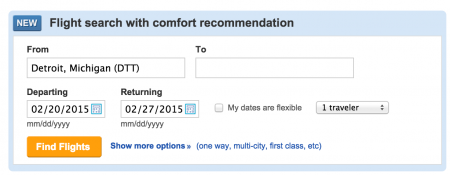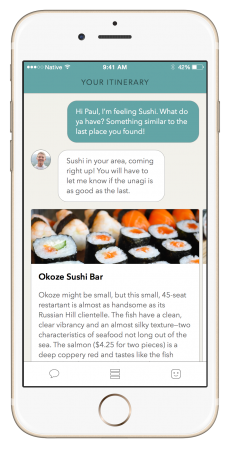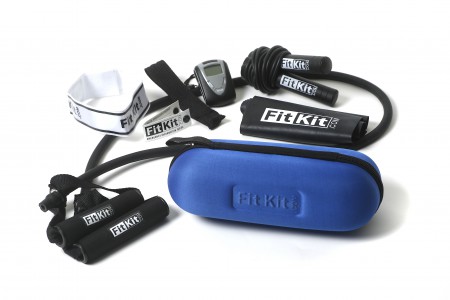
As I walked off the flight from one of my first business trips, I found a sales leader I met getting on that plane. We walked on in unison and chatted like peers — until I veered toward baggage claim. “You checked your bag?!” He asked loudly. Before I could answer, he lifted his bag, said the flight attendants also use that size, muttered something about “standard regulation” and then, as we started to split, shouted these words after me: “You’ll learn, Kristy!”
Just like that, I was dubbed business travel amateur, right there in the middle of DTW.
He, on the other hand, remained right on point, efficient in even his exit, not skipping a step over the course of his entire business-travel lesson. And that’s what it takes to be a sales leader today: an ability to find efficiencies everywhere, including the airport.
Here are 11 tips that will help you do the same for your next trip:
1. Check out seatguru.com.
It takes skill to stay productive when the seat ahead of you reclines in your lap. Use SeatGuru, so you don’t have to worry about that. The service (by TripAdvisor) allows you to find flights based on seat comfort.

John Hulwick, VP of Sales at a predictive analytics SaaS company called SalesPredict, stands by this one: “I’m 6’4″, so it’s always important to have enough legroom on any flight. And, working on the plane is essential to make sure you walk in the door the next day without having to ‘catch up,’ ” he said. “I always check www.seatguru.com to check the legroom for my particular flight and confirm that wifi will be available.”
2. Stay at familiar hotels.
Do your travels take you to the same cities? Try to book the same hotels. Even if you consider yourself a travel warrior, it takes energy to orient yourself in new places and find restaurants, coffee shops or other trip needs. Stay somewhere familiar, and you can spend that energy on more important sales tasks.
3. Try the Native app.
Native, an app that calls itself “your new personal travel assistant,” launched in February and already won Colorado’s Google Demo Day. For $20/month, the software gives you 24/7 access to a travel service, which helps with booking, important travel notifications, easy access to travel documents and concierge-type advice.

4. Organize transit time ahead of time.
This one’s simple, but important: Make a pre-travel plan, so you won’t waste time in transit figuring out what to do.
As for what to do? William Bauer, Marketing Director for retailer Royce Leather, suggests starting with a decision on whether to be connected or not. “Both offer advantages for productivity,” he said. “If you choose to be totally connected, make a to-do list, and use flight time to catch up on emails, read articles you’ve been meaning to get to or take an online class. If you decide to disconnect totally, you can be productive without being distracted by online noise, tasks and entertainment. Use a good old-fashioned pen and paper to brainstorm, write, sketch ideas or plan a project.”
5. Sign up for TSA PreCheck.
TSA PreCheck provides expedited security screening — so you don’t have to take off your belt, shoes or jacket; remove your laptop; or deal with the longer lines of people who do.
LevelEleven CEO Bob Marsh invests in PreCheck and suggests that anyone who travels more than once a month do the same. “This is a huge time saver and not all that expensive at $85/year,” he said. “If you have an American Express Platinum card, you can get it for free.”
6. Invest in a Macbook Air (or a laptop similar in size).
A Macbook Air costs close to $1,000, but the productivity gained can be worth it.
Julia Kline, author of Amazon bestseller The Entrepreneur’s Guide to Sleaze-Free Selling, carries her 13″ Mac in her purse. “So with no effort or planning or inconvenience, I can be as productive as I am at the office, no matter where I find myself,” she said, adding these examples:
- Sitting in a boring session, but the walk elsewhere would blow the available window of time
- Unexpectedly delayed in a cab or at an airport gate
- Stuck behind a far-reclined seat on a flight (…but you shouldn’t have to worry about that now that you know about SeatGuru, right?)
7. Bring hard copies of work.
Bringing hard copies of work allows you to stay productive during times when you need to turn off devices or deal with spotty plane wifi.

8. Pack hearty snacks.
If you have time to catch up on work in your room, what’s more distracting than being hungry? It helps when you can grab a filling snack — like oatmeal, nuts or granola bars — from your suitcase, instead of having to break to find the nearest restaurant.
(Need ideas on good travel snacks? Here are a few from Buzzfeed.)
9. When shipping anything to your hotel, CALL ahead.
Many of you are right in line with this guy:
But did you know that some hotels will only hold packages for small windows of time before your arrival? I didn’t. Then one hotel sent my package back for being 48 hours early, which sent me running around Manhattan to three FedEx stores, one of which told me to try “the print center inside of the Chinese restaurant a few blocks over.” Entertaining yes, productive no.
If you know your hotel won’t send back your goods, still call ahead and ask for your package to be at your room upon check-in. Then you won’t have to wait at the desk as hotel staff tracks it down.
10. Be diligent about on-the-road workouts.
It’s easy to let travel throw off your workout routine. Resist. Bob Marsh supports this one too, warning: “Exercise is probably even more important [on the road], as travel can drain you more than you often realize.”
If you’re unsure about gym options, check out portable fitness equipment packs like FitKits, which are two pounds and carry-on friendly. Or, bring running gear — getting outside can also help you feel like you’re getting away, which is refreshing on its own level.

11. And of course, purchase the largest carry-on allowed so you won’t have to check luggage.
Condé Nast Traveler reports that most major airlines allow a maximum size of 22” x 14”x 9”, which most luggage makers refer to as a 22” bag.
You won’t be dubbed an amateur right in the middle of DTW, or get distracted by just how confusing it can be to find Baggage Claim, like this bag-checker:
If you have tips to add, we’d love to see them in the “Comments” section. Happy travels.





I’ve always taken the approach of using a good quality backpack for my carry on as opposed to actual carry on luggage. More often than not I seem stuck on full flights with “limited carry on space” available, and if I had anything larger than a backpack then it probably wouldn’t fit in the room that was left near my seat and I’d be forced to gate check it. With a backpack, not only is it easier to squeeze into overhead compartments, but worst case scenario I can throw it under the seat in front of me if I want to forfeit leg room for having my gadgets in the cabin with me. Also, the many compartments in a backpack are great for dividing up the essentials; one area for chargers and cables, another for small electronics, laptop in another, etc. I’ve come to know what each compartment should have, which also makes double checking my bags when I check out of my hotel nice and fast too.
Good call, Steve. If they end up checking your bag at the gate, kind of defeats the purpose of not checking luggage in the first place! Thanks for sharing!
I always make sure to bring one of those travel/portable power strips/ surge protectors. They come in very handy with the lack of outlets everywhere while traveling… plane seats, hotel rooms, airports etc. Highly recommend investing in one!
The familiar hotel thing can save time and money every single trip. And if they have great in building services, why go else where?
The Cocoon Grid-It is a great little product that helps keep all your cords, adapters, and headphones organized and untangled.
I always make sure to arrive early and get some food before actually stepping on the plane.